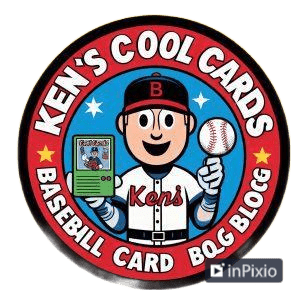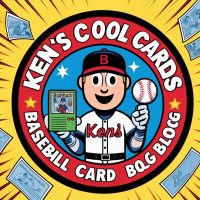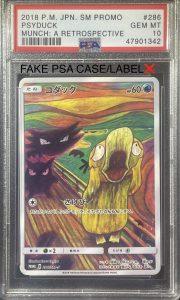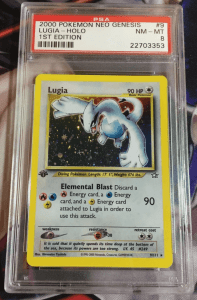How to Spot Fake PSA Slabs QUICKLY
If you’ve spent any time in the card community, you’ve probably heard stories about fake PSA slabs floating around. There are lots of videos (especially one of my favorites…Dan the Card Man…who is ALWAYS ruthless with PSA and we are HERE FOR IT and he’s worth a sub!).
Whether you’re buying online or at a show, the risk is real—and it’s getting tougher to spot the difference. But don’t worry: with a little know-how, you can dodge those graded card scams and protect your collection like a pro.
Let’s break down how to spot fake PSA cases quickly, without needing a forensic science degree.
What Are PSA Slabs and Why Fakes Matter
When a card is graded by PSA (Professional Sports Authenticator), it’s sealed in a tamper-evident plastic holder with a label that shows its grade, serial number, and other info. These PSA slabs are trusted across the hobby, but scammers are becoming increasingly sophisticated, creating counterfeit PSA holders that appear shockingly authentic.
Why do they do it? Simple: the value. A raw card might be worth $20, but slabbed in a fake case marked “Gem Mint 10,” some poor soul might pay $ 200 or more. That’s why knowing how to check for a real vs fake PSA slab is essential.
Top Signs of a Fake PSA Slab
Here are the dead giveaways:
- The label looks off. Check the spacing between letters, font thickness, and logo clarity. PSA labels are precise. Fakes? Not so much.
- Weird plastic feel. PSA uses high-quality, tamper-proof cases. If the slab feels cheap or “squishy,” run.
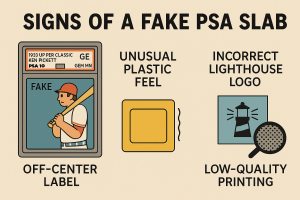
- Lighthouse logo error. Since 2017, all legit PSA slabs feature a subtle “lighthouse” watermark on the front. If it’s missing—or blurry—it could be a fake PSA slab.
- Poor seal. Real slabs are ultrasonically sealed. A poorly closed case might mean PSA slab tampering.
Depending on how sophisticated the fake is, even seasoned collectors can be fooled. Some are scarily close to the real deal. But if you’ve got basic knowledge, a keen eye, and a bit of awareness, you’ll be in a much better spot to avoid getting taken.
The PSA Label: Small Details Matter
Every slab has a label, and it’s packed with clues. Here’s what to zero in on:
- Ink and printing. PSA uses fugitive ink, which looks different from basic printer jobs. If the ink bleeds or smudges, that’s a red flag.
- Cert info. Each slab has a unique number—more on that in a second.
- Set details. If you know the card (say, a 2022 Topps Julio Rodríguez RC), and the label info is wrong or vague, beware.
Use a mental (or literal) PSA slab checklist every time: logo, ink, font, spacing, printing. It’s not overkill—just good collecting.
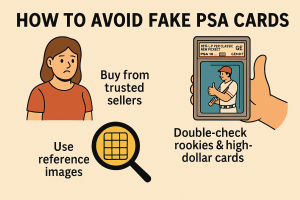
PSA QR Code & Cert Number: Use the Tools
PSA makes it easy to do a PSA QR code check right on your phone. Just scan the code on the slab’s label, and it should take you to PSA’s website, where you’ll see:
- A photo of the actual card
- Set name and grade
- Certification status
You can also enter the cert number manually on PSA’s site for PSA label verification. If the card you’re holding doesn’t match what PSA says, it’s likely a fake.
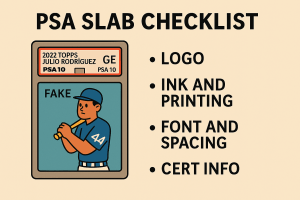
Smart Tips to Avoid Fake PSA Cards
Here’s how to stay safe:
- Buy from trusted sellers. If you’re on eBay, look for high-feedback sellers who specialize in graded cards.
- Trust your gut. If a deal feels too good, it probably is.
- Use reference images. PSA’s site and forums often have legit slab pics. Compare!
- Double-check rookies and high-dollar cards. These are the most commonly faked.
Personally, I use the r/baseballcards subreddit regularly—it’s super helpful for checking authenticity or just getting second opinions. Sure, some folks on there are toxic or act like jerks, but most of them? Pretty cool peeps who love the hobby and are happy to help.
Final Thoughts
Knowing how to spot fake PSA slabs is a key skill for any serious collector. The scammers are out there, but with sharp instincts and a little practice, you’ll spot them from a mile away.
Even the best in the hobby get fooled sometimes—it happens. But if you’re aware of the red flags and you lean on solid resources, you’ll save yourself a lot of heartache.
So keep collecting, stay sharp, and remember—when in doubt, check it out.
